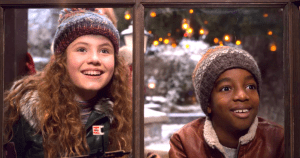Reviewed by Jeffrey Sanzel
In 2018, Netflix released The Christmas Chronicles, a warm comedy with a wonderfully edgy center. It followed siblings Kate and Teddy Pierce who almost prevented Santa from making his deliveries. While it had plenty of fantasy, it was rooted in the reality of children coming to terms with the passing of their father, a fireman who died in the line of duty. Each child was struggling in his or her own way but grew from their encounter with Santa.
Darby Camp and Judah Lewis were both understated and grounded as the children, with Darby’s believing sister playing nicely off of the skeptical and borderline delinquent brother. While Kimberly Williams-Paisley, as their mother, Claire, didn’t have much screen time, she managed to impart the difficulty of being a single parent. The heart of the film was Kurt Russell’s Santa, both hilarious and extremely cool. Russell reinvented St. Nick without losing sight of the symbolic heart.

The first film had a clever, solidly constructed screenplay by Matt Lieberman, complemented by Clay Kaytis’ smart and well-paced direction. It was produced by Chris Columbus who has now taken up the directorial reins for the sequel, The Christmas Chronicles 2, and has co-written the screenplay with Lieberman and Enrico Dante-Mann.
From the beginning, it is apparent that the sequel will take a completely different approach. It opens in a world of cold which is later to be revealed as the North Pole in all its whimsy. It establishes the villain, Belsnickel, and his plot to destroy Santa’s world.
The action then shifts to Mexico. Kate, now a frustrated teen, is unhappy with her mother’s new relationship. The Pierces —Kate, Teddy, and mom — are on vacation in Cancun with mom’s new beau, Bob, and his neurotic son, Jack. These few scenes are stiff and false. They play as the most basic exposition, stating the characters’ intentions, rather than allowing the complications to reveal themselves in context. In every way, it lacks the subtlety, finesse, and honesty of the first movie.
Very quickly, Belsnickel captures Kate (and, accidentally, Jack) and uses them to break the veil of Borealis that protects Santa’s village. Belsnickel makes bold statements about Santa falling into his trap. If he had a mustache, he most certainly would be twirling.
Santa rescues the frozen Kate and Jack, and Mrs. Claus heals them with magic hot chocolate. Santa and the Missus give them a tour of the Village, with elves making toys and candy in shades of Willy Wonka. Emphasis is placed on the Village’s power source, the Christmas Star that contains a bit of the Star of Bethlehem.
The Clauses allow the children to stay overnight. There is a strange moment when Mrs. Claus, unprompted, decides to tell them the history of Santa Claus, beginning with his origin as a bishop in Turkey, then segueing into elf lore. From there, it gives an account of Belsnickel, a talented but naughty elf who rebelled; his behavior turned him into the thing he despised the most — a human. Again, rather than showing and revealing, his saga was shoehorned into this awkward and rather dark bedtime story.
Belsnickel poisons the elves with elfbane, making them crazy and then steals the star for his own village. He wants to reverse the curse that has been placed on him and sums up his frustration with rather ineloquent “Humans suck; elves rule.” Belsnickel seems to be crafted less as a traditional Christmas antagonist and more as a lesser supervillain.
With the Village no longer powered by the Star, Santa and Kate fly off to Turkey to see the Forest Elves and magical elf elder Hakan (voiced by Malcolm McDowell) to have a new Christmas Star fashioned. Jack remains with Mrs. Claus to solve the elf problem.
Then there is the wormhole that rends the fabric of time, a “spontaneous” musical number in a snowbound airport and featuring a terribly underused Darlene Love, a Nerf crossbow, flame-shooting drones, and a yule-cat that looks like a Saber-toothed tiger … There is a lot of busyness but little focus and even less purpose. Needless to say, it all works out in the end.
Kurt Russell is still delightful in his hip take on the holiday icon but there is less of the wry perspective and surprising magic. Gone is the wonderful, quirky knowingness that was the center of his St. Nick. Goldie Hawn, who had a cameo at the end of the first film, seems uncomfortable as Mrs. Claus, trying to make her both traditional and feminist, magical and maternal. Julian Dennison’s Belsnickel plays what he is given but, of all the characters, his lines are the most wooden; there is potential in his portrayal but the screenplay truly lets him down.
Darby Camp is given the unenviable task of representing every sulky teen and the writers do nothing to help her find the transition to understanding. Jahzir Bruno’s Jack is lifted from any number of sitcoms but he’s likable enough as the nerdy, sensitive sidekick. Judah Lewis, as Teddy, is barely in the film; Kimberly Williams-Paisley (as Kate and Teddy’s mom) even less so. Sunny Suljic has some nice moments and a good reveal in the airport scene, set in 1990 Chicago.
The Christmas Chronicles cleverly shared its message, wrapped up in plot-driven action and sly humor. In The Christmas Chronicles 2, the morals are flatly stated. The comedic elements are forced jokes, and the action is adventure for adventure’s sake. In real life when people announce what they’re going to do and do it, we appreciate that. In movies, not so much.
The Christmas Chronicles 2 is strictly for children (though there is one violent moment involving an attack on one of the reindeer). There is an emphasis on the elves who are extremely cute gremlin-like creatures with their own chattery language. In the first film, they didn’t appear until the end and were a fun surprise. Here, they are wedged into every possible moment, most likely with an eye on marketing their likenesses in plush toys and Happy Meals.
The elves — like the Village, like the reindeer — are CGI. Actually, the entire film seems to be computer generated — add Santa, cute children, a rogue elf, lessons on bravery and decency — compute — and out pops a finished product. What is missing is inspiration and humanity and dimension.
At the center of both films is the idea of being a true believer. The idea is that by believing in Santa, you believe in Christmas, and by taking Christmas into your heart, you connect with the joy and opportunity in the world. Those are big concepts and good sentiments. In the first film, the idea is nicely baked in; here, the principles aren’t so much integrated as slathered on top like a moral condiment.
Last week, I offered a mixed review of Jingle Jangle: A Christmas Journey. But the difference is that Jingle Jangle’s intentions are clearer, its goals more connected, and, ultimately, provides a more rewarding experience. Jingle Jangle is problematic but there is the underlying love and wonder. The Christmas Chronicles 2 seems to be locked into the commerce of sequels — the use of a success to sell an inferior product. And perhaps some elfin merchandise.
Rated PG, The Christmas Chronicles 2 is now playing in local theaters and streaming on Netflix.







